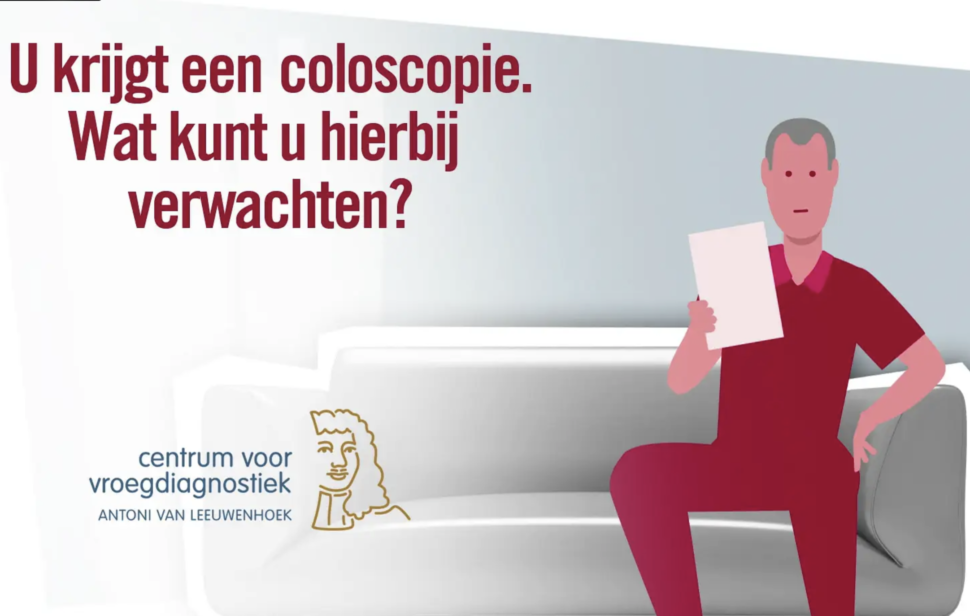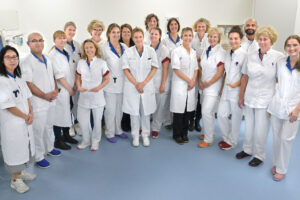What to expect during colorectal diagnostics?

Colorectal cancer diagnostics in 6 steps
Step 1. Preparations at home
After your registration/referral, you will receive a comprehensive questionnaire from us by email and our app.
Step 2. Intake consultation
During the intake consultation at our Center, we determine whether a colonoscopy is suitable for you. If so, we will discuss the colorectal examination, like whether you want sedation during the procedure.
Step 3. Preparations at home
To examine the colon properly, it needs to be clean and empty. This means that you cannot eat before the procedure and that you will have to prepare your bowels: the day before your procedure you will have to take a laxative which will make you go to the bathroom frequently to empty the bowels. Your stool will be thinner than usual.
Step 4. Colonoscopy
You may receive a sedation via an intravenous infusion depending on the agreement you made during your intake consultation. You will lie down on your side on the examination table. During the colonoscopy we insert a thin tube with a camera into your body through the anus. This tube ill gradually go further inward to allow us to examine your colon. Air will be pumped into the bowels to create more space. As a result, you may need to pass gas during or after the examination. If we detect polyps during the examination, we can almost always remove them immediately. You won’t feel anything during this process. The examination typically lasts between half an hour and an hour.

Step 5: Preliminary Results
Immediately after the procedure, you will be informed about our findings. You will receive a preliminary result based on these findings.
Step 6: Final Results
If polyps were removed during the procedure, they will be examined by a pathologist. Are there any abnormal cells present or not? You will be notified by phone after about a week whether or not there is colorectal cancer.
Results of the colorectal cancer examination
There are three possible outcomes:
- No colorectal cancer or polyps were found
This is good news. You won’t need to be screened for colorectal cancer over the next 10 years and won’t need to send in a stool sample if you receive the at-home test kit.
- Polyps have been detected
Polyps in the colon are not cancerous, but they can develop into colorectal cancer. You will receive another invitation from our Center for a follow-up examination in 3 to 5 years.
- Colorectal Cancer has been detected
If we diagnose you with colorectal cancer, we will refer you for treatment. Our Center only provides the diagnosis. We are part of the Netherlands Cancer Institute, but you can be referred to another hospital if you prefer.
Your personal app
The NKI Center for Early Diagnostics uses a smart app for the screening process. This app contains all the information you need. Learn more about what you can expect on the day of your diagnostics, how to prepare, and find information tailored to your personal situation.
This app is currently only available in Dutch. Learn more:

Our friendly professionals work together towards early diagnostics and scientific research. You may meet them at our Center.
Blood in your stool is a sign that we need to investigate your bowels further. Blood in the stool can be harmless if it is caused by something like hemorrhoids. It can also mean that you have polyps or colorectal cancer.
A small lump can form in the lining of the colon. This is called a polyp. A polyp can be small and harmless. Most people are unaware that they have a polyp. Some polyps can grow, and new ones may appear quickly. Large polyps could develop into colorectal cancer. Removing polyps can help prevent colorectal cancer.
The intake is scheduled by the Rijksinstituut voor Volksgezondheid en Milieu (RIVM). You can only reschedule your appointment through the RIVM. There are two ways to do this:
Digitally:
Go to the population screening website and log in with your DigiD.
By phone:
A phone number for your region is provided on the confirmation letter from the RIVM.
Immediately after the intake, one of our staff members will schedule your colonoscopy for you. On average this means that you can be seen within 2 weeks.
A colonoscopy is an intestinal examination during which your specialist looks at the inside of your intestines. This is done by inserting a thin, flexible tube with a tiny camera through the anus. Air is blown into your intestines to widen the passage. This allows your specialist to view the inside of the intestines on a screen during the procedure. If your specialist finds polyps during the examination, these will be removed immediately and examined later. You won’t feel anything when the polyps are removed.
Inserting the endoscope into the anus and advancing it into the colon can cause discomfort or pain. We offer a mild sedative or pain relief during the procedure. Your nurse or nurse practitioner will discuss the options with you during your intake consultation.
You decide whether you prefer sedation during your colonoscopy. If you choose to be sedated, we will give you a calming agent that helps you feel the procedure less strongly. It is not an anesthetic: most people do not fall asleep when sedated. The sedation is administered through a small tube (IV) inserted into a vein in your hand or arm.
Advantage:
- You feel less of the procedure and are able to relax during the colonoscopy.
Disadvantages:
- You will need to stay longer at the Center after the colonoscopy to recover in the recovery room.
- You cannot perform certain activities immediately after the procedure, as the risk of errors is higher following sedation.
- You cannot be in traffic on your own, which means that you cannot bike or drive. You will need someone to take you home after the colonoscopy.
- You may feel groggy on the day of the procedure, which can make it harder to remember what the doctor or nurse tells you.
In most cases, you can watch during the colonoscopy. There is a large screen on which your physician views the inside of the intestine. Usually this screen will be positioned in such a way that you can also see the images.
If you were not sedated during the procedure, you can return to work immediately if you feel well enough for it.
If you have been sedated, you might feel a bit groggy after the procedure. If this is the case, please take it easy for the rest of the day. We do not recommend returning to work on the day of the procedure.
- Extra underwear or a pad for your underwear, in case you experience any unexpected bowel movements.
- Something to eat after the colonoscopy. We will provide a piece of gingerbread, but you can also bring your own food. The NKI Center for Early Diagnostics does not have a restaurant, but there will be a snack dispenser available. The Netherlands Cancer Institute (across from our Center) has a restaurant and coffee bar.
- If you use a CPAP mask for sleep apnea and have chosen sedation, please bring your mask and use it during the procedure.
Immediate preliminary results:
You will receive the preliminary results of the examination immediately after the colonoscopy. The specialist will inform you whether polyps have been found, and provide an initial assessment of the likelihood of colorectal cancer.
Final results after one week:
After approximately one week, you will receive your results through a phone call. If polyps have been found, the pathologist will have had time to examine them further. This will confirm whether colorectal cancer is present.
The person who accompanied you to the appointment cannot come inside with you. They will need to wait for approximately 1 hour. They can wait in the waiting area of the NKI Center for Early Diagnostics. We do not have a restaurant, but we do have a snack dispenser available here. Your support can also visit the Netherlands Cancer Institute across the street, which has a restaurant and a coffee bar available.
The costs of the follow-up examination are covered by your health insurance. There is a chance that you may have to pay some or all of the costs yourself. This depends on your deductible (eigen risico).
Contact your health insurer for more information about coverage.
